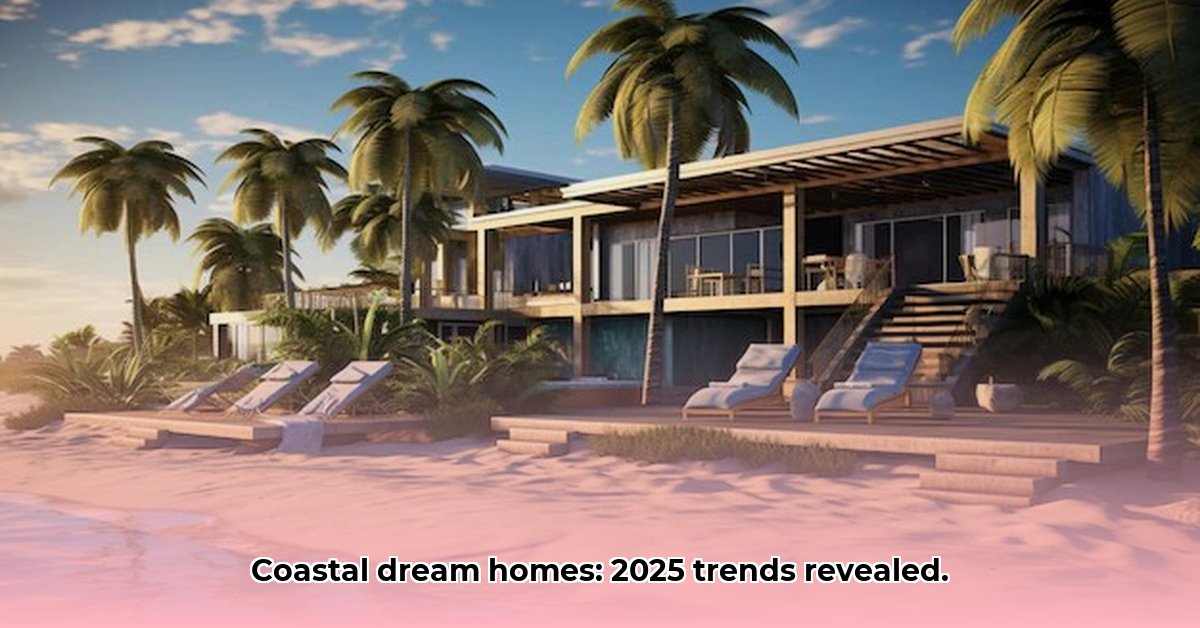Dreaming of a beach house that transcends the ordinary? Forget tired seashell clichés. Contemporary coastal homes redefine luxury, sustainability, and resilience. This article explores the evolving world of modern beach house design, showcasing how innovative architects are crafting stunning, enduring spaces. Discover the latest trends, address coastal construction challenges, and glean insights for planning your perfect seaside retreat. Prepare for inspiration! For more stunning examples, see these modern luxury homes.
The Evolving Coastal Aesthetic: Design and Architecture
The traditional beach house is being reimagined. Instead of quaint, potentially dated cottages, we’re seeing the rise of stunning, sustainable, and stylish sanctuaries. This transformation is driven by nature appreciation, innovative building techniques, and the demand for resilient, beautiful homes. Coastal living in 2025 and beyond blends luxury with environmental responsibility, responding to climate challenges and homeowner desires.
Redefining Coastal Living: Integrating Comfort and Resilience
The outdated postcard image of a beach house is fading. Today’s coastal homes offer sophisticated design, environmental mindfulness, and unparalleled durability, creating an intersection of luxury, comfort, and long-term resilience. Fueled by growing demand for second homes, amplified environmental consciousness, and innovative building science, these homes are relaxing getaways built to withstand natural elements.
Pivotal shifts in coastal beach house design:
- Elevated Durability: Contemporary designs prioritize materials and construction methods that withstand harsh coastal conditions, including salt spray, high winds, and potential flooding.
- Sustainable Integration: Eco-friendly practices are central, including minimizing environmental impact through material choices, promoting energy efficiency with renewable energy systems, and preserving local ecosystems.
- Aesthetic Sophistication: Moving beyond clichés, modern beach houses embrace sleek designs, luxurious finishes, and architectural styles that complement the natural landscape.
Sustainable Seascapes: Green Building and Eco-Conscious Design
Sustainability is foundational in modern coastal design. Architects are utilizing biophilic design principles to maximize natural light and ventilation, decreasing energy consumption while connecting residents to the surrounding environment. Smart home technology allows for energy-efficient control and remote management. Embracing sustainability benefits homeowners financially and reduces environmental impact.
Did you know? Biophilic design, incorporating natural light, natural materials, and ventilation, can reduce energy consumption by up to 30% and improve occupant well-being.
Material Selection: Balancing Durability and Sustainability
Selecting materials for a sustainable and hurricane-resistant coastal home requires careful consideration. Materials are crucial for resilience against the elements. Fiber cement siding, metal roofing, and impact-resistant windows are essential. Fiber cement siding withstands moisture and pests, while metal roofing protects against wind and debris. Impact-resistant windows act as a storm shield, protecting interiors from flying debris. Sourcing sustainable and locally available materials further reduces environmental impact.
Weather-Resistant Architecture: Building for the Long-Term
Coastal architecture faces increasing threats from climate change, including rising sea levels and extreme weather events. Innovative, durable designs are crucial for protecting homes and communities.
Considerations for building weather-resistant coastal beach houses:
- Prioritize Weather Resistance: Select materials known for longevity and ability to withstand harsh coastal conditions. Consider the Specifics of each climate, from hurricane-prone regions, to areas with intense sun or high humidity.
- Opt for Durable Exteriors: Choose fiber cement siding or metal roofing with PVDF 70/30 coatings to resist corrosion and fading. Explore options like reclaimed wood treated for marine environments for added sustainability.
- Ensure a Solid Foundation: Use pilings and robust construction techniques to elevate the structure and protect against shifting sands and flooding. Consider reinforced concrete foundations for maximum stability.
- Integrate Sustainable Options: Consider reclaimed wood, recycled plastic composites, and bamboo-based materials to reduce environmental impact and promote resource efficiency.
- Adhere to Local Codes: Comply with coastal building codes and regulations to ensure safety, structural integrity, and environmental protection. Consult with local building experts to incorporate best practices for coastal construction.
Integrating Smart Home Technology: Convenience, Efficiency, and Resilience
Smart home technology enhances coastal living by offering convenience, security, energy efficiency, and weather resilience. Integrated systems that control lighting, temperature, security, and entertainment are increasingly popular. Individual smart devices have become widely available, expanding options for homeowners. However, cost, compatibility, and data privacy can pose challenges. Coastal environments require robust, weatherized smart home solutions, including surge protection and backup power systems.
Pro Tip: Smart thermostats and humidity sensors optimize energy use, reducing carbon footprint and energy bills. Leak detection systems can prevent water damage from storms or plumbing failures, mitigating costly repairs.
Harmonizing Architecture: A Collaborative Effort for Coastal Preservation
Building a sustainable coastal future requires collective action. Architects, designers, developers, homeowners, policymakers, and regulators play key roles. Transparency, communication, and ethical practices are vital for protecting coastal resources and building resilient communities. Coastal homes of tomorrow will be shaped by ongoing research and development, data-driven decision-making, and adaptive management strategies.
- Contemporary Kitchen Backsplash Ideas for a Stylish Home - December 20, 2025
- Modern Kitchen Backsplash Ideas To Inspire Your Refresh - December 19, 2025
- Modern Backsplash Ideas: A Guide to Todays Kitchen Trends - December 18, 2025










